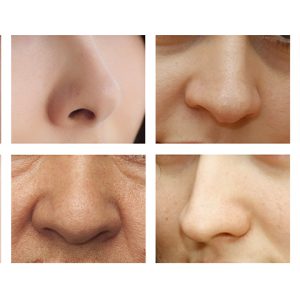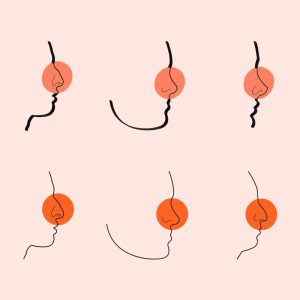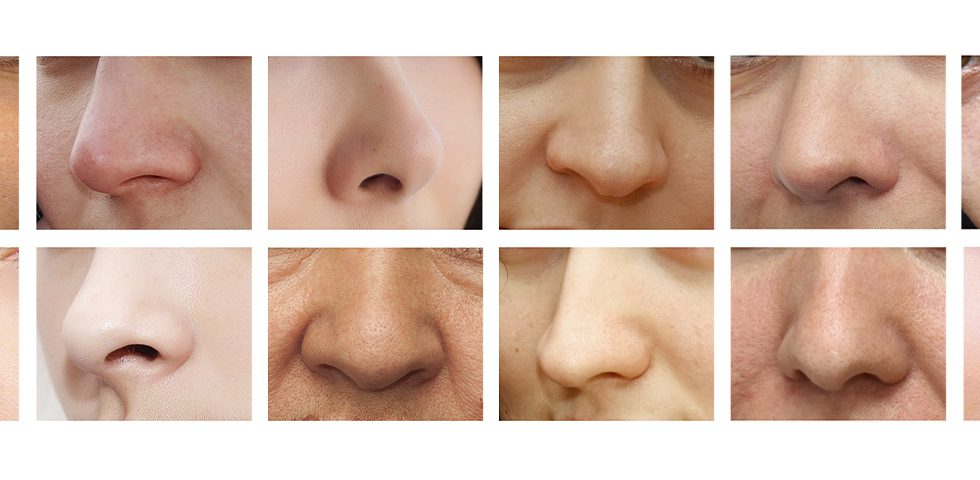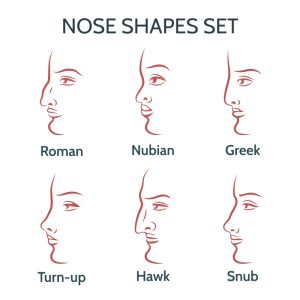The human nose is a remarkable feature that not only serves the basic functions of breathing and detecting odors but also contributes significantly to our overall facial appearance.
There are different types of noses and each person’s nose can have unique characteristics. It is important to appreciate and embrace all this diversity of nose shapes that make us who we are, even if they do not conform to a specific ideal, and to recognize that beauty comes in many forms. As all these nose types carry their charm, it adds to the uniqueness of each individual.
Different Nose Types and What Are the Surgical Options to Correct Them?
Types of noses, each with its unique specialties are as diverse as people. Noses can become the way they are now for various reasons with some external factors and may need some correction by a medical operation while some are born the way they are and they may not need any correction if they also don’t affect the health.
Here are some common nose types and the surgical options available to correct them:
-Dorsal Hump: A dorsal hump refers to a noticeable bump or convexity along the bridge of the nose. Surgical correction for this condition is typically performed through rhinoplasty. During the procedure, the surgeon can carefully shave down or reduce the prominence of the hump, resulting in a smoother profile.
-Droopy or Ptotic Nose: A droopy or ptotic nose type is characterized by a nasal tip that hangs downward or lacks definition. This condition can be corrected through rhinoplasty, which may involve techniques like tip elevation, cartilage grafting, or septoplasty to improve the nasal structure and achieve a more lifted and refined appearance.
-Deviated Septum: A deviated septum refers to a condition in which the nasal septum, the wall that separates the nasal passages, is crooked or off-center. This can cause breathing difficulties and affect the overall appearance of the nose. Surgical correction for a deviated septum is called Septoplasty. During this procedure, the surgeon repositions or removes parts of the septum to straighten the nasal passage and improve breathing.
-Nasal Asymmetry: Nasal asymmetry occurs when the nose is visibly uneven or lacks balance in terms of shape or position. Rhinoplasty can be performed to address this issue by reshaping and repositioning the nasal structures to achieve a more symmetrical appearance.
It’s important to note that each individual’s nose is unique, and the surgical options may vary based on specific anatomy and desired outcomes. Consulting with a qualified plastic surgeon or facial plastic surgeon is crucial to evaluate your nose type, discuss your goals, and determining the most appropriate surgical options for you.
What type of nose do you have?
The world of nose shapes is vast and captivating. From the graceful curves of a Roman nose to the charming button-like appearance of a snub nose, the diversity of nose shapes is captivating, thus we can foster a greater sense of self-acceptance and celebrate the individuality of others.
There are some general different nose types known around the world:
Fleshy Nose
A Fleshy Nose is a term used to describe a nose with relatively thicker and soft nasal tissue, resulting in a fuller or more rounded appearance. It is often associated with a wider nasal bridge and a plump nasal tip. The term “Fleshy Nose” is more of a descriptive term rather than a specific medical or anatomical classification.
Upturned Nose
An Upturned Nose, also known as a Retroussé Nose, is a nose shape characterized by a nasal tip that is elevated or tilted upward. This creates an appearance where the nostrils are more visible, and the tip may have a slightly rounded or curved shape. The upturned nose often imparts a youthful and perky look to the face.
Hawk Nose
A Hawk Nose, also called a Hooked Nose, is characterized by a prominent and downward-curved bridge with a distinctive hook at the nasal tip. It can give the appearance of a strong and striking facial feature.
Cape Greece
Also known as the “Greek nose” and named after the Greek gods and goddesses, this type of nose, which is mostly used to describe the general nasal structure of that period, does not have any protrusion or fluctuation on the dorsum of the nose, and the forehead and the dorsum of the nose are almost on the same plane.
Cape Roma
A Roman nose, also known as an Aquiline (The word ‘’Aquiline’’ comes from the Latin word Aquilinus “eagle-like”) Nose, is a facial feature characterized by a prominent, slightly curved bridge that gives the nose a distinct shape and it is often associated with strength, power, and nobility and it has also been depicted in art and literature throughout history.
Humped Nose
A humped nose, also known as a Dorsal Hump, Bump on Nose, or a Roman hump, refers to a prominent bump or convexity on the bridge of the nose. When surgically correcting a humped nose, the bones, and cartilage are cut and removed from the nose

Nixon Nose
The term “Nixon Nose” refers to the nasal shape and appearance of former U.S. President Richard Nixon. It is characterized by a prominent, slightly bulbous tip with a downward curvature.
Bulbous Nose
A wide or bulbous nose is characterized by a broad nasal bridge or a rounded and wide nasal tip. Surgical options to correct this include rhinoplasty techniques such as tip refinement and alar base reduction.
Combo Nose
A Combo Nose is any nasal form combining different nasal shapes that is a mixture of all kinds of noses. It’s a unique nose type that people do have it rarely.
Snub Nose
The Snub Nose, which means “A nose that is short and turns upwards at the tip”, also known as Button Nose or Pig Nose, has a distinctly thin and pointed appearance.
Nubian Nose or African Nose
The term “Nubian nose” or “African nose” is often used to describe a particular nose shape or nasal feature associated with individuals of African descent. It refers to a broader and flatter nose shape with a wider nasal bridge and nostrils.
Cape East Asia
The Cape East Asia Nose, a nose type mostly seen in East Asia, has a thin, flat shape and a shorter tip. It is characterized by smallness and flatness and is most common in countries such as China, Hong Kong, Korea, and Taiwan.
Rhinoplasty Surgeries for Different Nose Types
Nose Surgery has already taken its place among the aesthetic operations that people of all age groups have frequently applied in recent years. Because most of people, these days, prefer to change the shape of the nose they have.
Rhinoplasty Surgery commonly known as a Nose Job, is a surgical procedure performed to enhance the appearance or function of the nose and it is considered at the top of surgeries for different nose shapes.
Here are some common nose types and the associated Rhinoplasty techniques:
Reduction Rhinoplasty
Reduction Rhinoplasty is a type of Rhinoplasty procedure performed to reduce the size or dimensions of the nose. It is commonly sought by individuals who feel that their nose is too large or disproportionate to their facial features. Reduction rhinoplasty can address various aspects of the nose, including the bridge, tip, nostrils, or overall size. Here are some key considerations and techniques involved in the Reduction of Rhinoplasty:
Post-Traumatic Rhinoplasty
Post-traumatic rhinoplasty is a surgical procedure performed to correct nasal deformities or functional issues that result from trauma or injury to the nose. It is a specialized form of rhinoplasty that focuses on restoring both the aesthetic appearance and the functional aspects of the nose.
Augmentation Rhinoplasty
Augmentation rhinoplasty, also known as nasal augmentation or nose augmentation, is a surgical procedure performed to enhance the shape, size, or projection of the nose. It involves adding volume or structural support to specific areas of the nose to achieve the desired aesthetic outcome.
Corrective Rhinoplasty or Revision Rhinoplasty
Corrective rhinoplasty, also known as revision rhinoplasty, is a surgical procedure performed to correct or improve the results of a previous rhinoplasty surgery. It is specifically tailored to address issues that may have arisen from the initial procedure, such as functional problems, aesthetic dissatisfaction, or complications.
Reconstructive Rhinoplasty
Reconstructive rhinoplasty is a surgical procedure performed to restore or reconstruct the structure and function of the nose following trauma, injury, congenital deformities, or the removal of tumors or lesions. It focuses on repairing and rebuilding the nasal framework to improve both the aesthetic appearance and the functionality of the nose.
Improvement Rhinoplasty
Improvement rhinoplasty, also known as Secondary Rhinoplasty is a surgical procedure performed to refine or enhance the results of a previous rhinoplasty surgery. It is typically done to address residual aesthetic or functional concerns that were not fully resolved or have arisen after the initial procedure.
Other Types of Nose Surgery
There are three distinct procedures related to the nose. Here’s an overview of each and the types of surgeons who typically perform them:
Septoplasty Surgery
Septoplasty is a surgical procedure performed to correct a deviated nasal septum which is the thin wall of cartilage and bone that divides the nasal cavity into two nostrils. After the surgery, deviated or displaced septum that obstructs the airflow, causes breathing difficulties, and contributes to other nasal issues is reshaped, repositioned, or removed to create a straighter nasal passage.
Turbinoplasty Surgery
Turbinoplasty, also known as turbinate reduction surgery, is a surgical procedure performed to address enlarged or swollen turbinates within the nasal cavity. During a turbinate reduction surgery, the surgeon aims to reduce the size or volume of the turbinates to improve nasal airflow and alleviate congestion.
Alarplasty Surgery
Alarplasty, also known as alar base reduction surgery or nostril reduction surgery, is a cosmetic surgical procedure performed to alter the shape or size of the nostrils. It is commonly done to address wide or flared nostrils and achieve a more balanced and proportionate appearance of the nose.
Different Types of Sinus Surgery
There are several different types of sinus surgery, each designed to address specific sinus conditions and symptoms. Here are some common types of sinus surgery:
Endoscopic Sinus Surgery
Endoscopic sinus surgery (ESS) is a minimally invasive surgical procedure performed to treat chronic sinusitis and other sinus-related conditions. It involves the use of an endoscope, which is a thin, flexible tube with a light and camera at its tip, to visualize and access the sinuses.
Balloon Sinuplasty
Balloon sinuplasty is a minimally invasive surgical procedure used to treat chronic sinusitis and other related sinus conditions. It is an alternative to traditional sinus surgery that involves the use of small balloons to open up blocked sinus passages and restore normal sinus drainage

What is the difference between Surgical and Non-surgical Rhinoplasty?
The main difference between Surgical and Non-surgical Rhinoplasty lies in the methods used to modify the appearance of the nose. When Surgical Rhinoplasty is a procedure that involves making incisions to access the underlying bone and cartilage of the nose under general anesthesia or local anesthesia with sedation for a wide range of concerns, Non-Surgical Rhinoplasty, also known as Liquid Rhinoplasty or Non-Surgical Nose Job, is a minimally invasive procedure that involves the use of injectable fillers or dermal fillers.
It’s also important to note that while Non-surgical Rhinoplasty can provide temporary results, it cannot achieve the same level of refinement or structural changes as Surgical Rhinoplasty.
When is Surgical Rhinoplasty right?
Surgical rhinoplasty may be considered as an appropriate option in several situations:
- Desire for Significant Changes
- Structural Issues
- Long-Lasting Results
- Complex Nasal Concerns
- Personalized Corrections
It’s essential to consult with a qualified and experienced plastic surgeon specializing in rhinoplasty to evaluate your specific concerns and goals. They will conduct a thorough examination, discuss your expectations, and provide professional advice on whether surgical rhinoplasty is the right choice for you.





1 Comment
Davian Lopez
18 September 2024 - 23:57Can a 14-16 have a nose job and, if so how much would you think it would cost